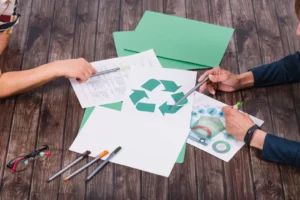Over time, the use of plastic has become significantly diverse. Its applications are now found in almost every industrial setup, including the medical world. Today, medical devices have advanced significantly and plastic is normally a by-product and is abundantly found in the vast majority of procedure and surgical equipment.
Medical plastics are a form of advanced polymers and special additives that are used for the production of medical devices. They possess properties such as sterility, extreme strength, flexibility, lightweight, electrical insulation and others that make them an ideal material for use in medical settings.
Nowadays, the recycling process has become increasingly popular because producing medical plastic devices requires a huge amount of energy and resources. The recycling process can be divided into two categories: mechanical and chemical.
What is Mechanical Recycling?
Mechanical recycling refers to the breaking down of medical plastics into small pieces called ‘pellets’, which can then be reused for further production of medical components or other items.
What is Chemical Recycling?
On the other hand, chemical recycling involves using chemicals like water or solvents to break down the medical plastic into its constituent molecules. This process is relatively efficient and can help to reduce the magnitude of waste generated during production. However, it may also produce toxic by-products that must be disposed of carefully.
Although medical devices are highly reliable and efficient, they can often be improved in terms of design. Instead of using petroleum-based plastic materials, bio-based alternatives could contribute to a much less harmful environment. Additionally, the use of multiple types of plastics and additives is not just inefficient but also painful when it comes to recycling or refurbishing purposes. Lastly, their packaging material along with delivery methods rank among the main flaws due to their ecological impact which oftentimes surpasses that of the device itself!
How is Different Polymer Used?
Polycarbonates
Polycarbonates are more commonly found in plastic eyewear and protective gear. They are quite abundantly used by doctors due to their mechanical strength and durability, as well as their ability to withstand extreme temperatures. When used for medical purposes, polycarbonates can be easily recycled by melting them down into a liquid state and moulding them into desired shapes. They are also useful because of their moldability and ability to reform at room temperature without cracking or anything of the sort.
Polystyrenes
Polystyrenes are found in disposable medical items like syringes, catheters and even drug delivery systems. Since these items are typically single-use, they can be disposed of without a problem. Polystyrenes can be recycled by melting them down and converting them into pellets that can then be used in other products. Polystyrene can also be reused after the manufacturing process to create other items of desired shapes and sizes.
Polypropylene
Polypropylene is also a common plastic used in medical devices. It is known for its stability, as it can withstand both hot and cold temperatures. This type of plastic is often used in medical equipment because of its lightweight and low cost. Polypropylene can be recycled by melting the material into liquid form, moulding it into desired shapes and sizes, and then cooling them down to create new products.
PET (Prosthetic based plastic)
PET is a synthetic polymer that is specifically used in prosthetic devices. It is highly flexible and lightweight, making it ideal for artificial limbs, implants and more. PET can be recycled by breaking down the material into small pieces and then melting them down to create new products. The process of recycling PET requires specialised machinery as it has a high melting point.
Medical plastics are a crucial component of the medical industry and play an important role in keeping patients safe and healthy.
How Medical Plastic is Sustainable?
Although, plastic is great in the present for human population, they have long-term sustainability just as well. Medical plastics are considered to be sustainable because they can be reused and recycled. Most single-used devices are made of medical-grade plastic which can be recycled to produce new items. This not only reduces waste but also saves resources that would otherwise have to be used in the production of new medical plastics. Additionally, recycled medical plastic can be upcycled into other products such as garden furniture or car parts. This diverts waste from landfills and reduces the demand for new plastic materials.
Concluding Thoughts
Overall, medical plastics are essential to the medical industry and have many benefits when it comes to sustainability. Recycling them can save resources, reduce waste, and help create new products from old materials. We should all strive to find ways to reduce our reliance on plastics and make sure that medical-grade plastic is recycled whenever possible. It is through our efforts that we can ensure a more sustainable future.
Additionally, the use of biodegradable plastics is becoming more and more popular. Biodegradable plastics are materials that can be broken down by living organisms, which makes them much more sustainable than traditional plastics.







